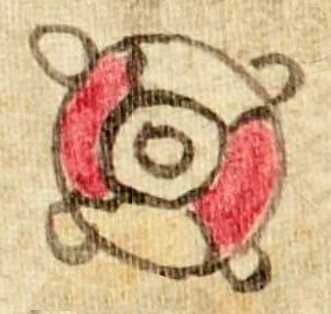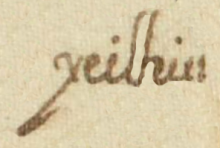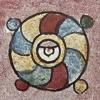ilhuitl (Azca12)
This simplex glyph for the day sign (ilhuitl) shows three concentric circles. The space between the outermost circle and the next one going inward is filled with alternating, spiraling red and white areas, two of each color. In the middle are two smaller concentric circles, just left natural. Around the outer perimeter of the largest circle are four tiny circles placed in what would be an X pattern if lines were drawn between them. The effect is to have the ilhuitl be shimmery or vibrant (perhaps with the small circles of tonalli), a form of movement that draws the viewer's eye around the circle.
Stephanie Wood
While the coloration is different from the ilhuitl glyph in the Codex Mendoza, the similarity is still significant. See below. Also, see the contextualizing image that includes the signs for the three days and four nights, during which time the comet was visible.
John Montgomery made a drawing of four of these signs, each one with a flag over it and therefore each one representing twenty days, for a total of eighty days. He drew this from the Codex Aubin 149. The presence of the flag really facilitates an understanding of the meaning of the sign, which should really be one day in its simplest form (without the flag), as it appears above.
Stephanie Wood
yeilhui
eyi ilhuitl (or eyilhui)
Stephanie Wood
post-1550, possibly from the early seventeenth century
Jeff Haskett-Wood
days, días, suns, soles

ilhui(tl), day, https://nahuatl.wired-humanities.org/content/ilhuitl
The Codex Azcatitlan is also known as the Histoire mexicaine, [Manuscrit] Mexicain 59–64. It is housed in the Bibliothèque Nationale de France, and hosted on line by the World Digital Library and the Library of Congress.
https://www.loc.gov/resource/gdcwdl.wdl_15280/?sp=12&st=image
The Library of Congress is “unaware of any copyright or other restrictions in the World Digital Library Collection.” But please cite Bibliothèque Nationale de France and this Visual Lexicon of Aztec Hieroglyphs.






